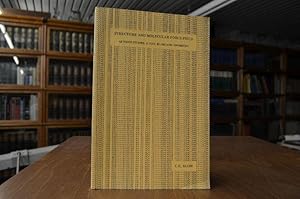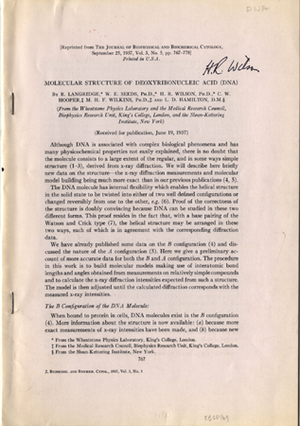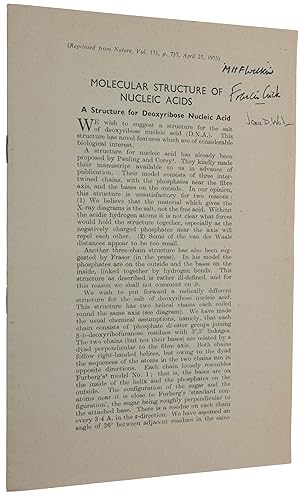Molecular Structure, Signed (6 results)
Product Type
- All Product Types
- Books (6)
- Magazines & Periodicals
- Comics
- Sheet Music
- Art, Prints & Posters
- Photographs
- Maps
-
Manuscripts &
Paper Collectibles
Condition
- All Conditions
- New
- Used
Binding
Collectible Attributes
- First Edition (4)
- Signed
- Dust Jacket
- Seller-Supplied Images (3)
- Not Printed On Demand
Free Shipping
Seller Location
Seller Rating
-
Relationships Between Molecular Structure and Photochemical Reactivity - Vapor Phase Photolysis of Cyclopropyl and Olefinic Ketones
Published by University of California, Riverside, Riverside, Ca, 1965
Seller: Vashon Island Books, Vashon, WA, U.S.A.
Signed
Hardcover. Condition: Very Good. No Jacket. Unpublished Disseration. xv+168 pages. Signed and inscribed by author. Blue cloth. Size: 4to - over 9¾" - 12" tall. Signed by Author(s). Book.
-
Structure and molecular force field. AB initio studies, a tool in organic chemistry. Dissertation der Rijksuniversiteit Leiden
Published by Leiden, Dissertationsdruck,, 1976
Book Signed
24 x 16 cm, Broschur. 103 S. Einband berieben und bestoßen. Innen sauber. Handschriftliche Widmung von Cornelis Eesge Blom auf dem Titel. Sprache: Englisch Gewicht in Gramm: 550.
-
Spectroscopic Studies of Molecular Structure." Reimpression de Les Prix Nobel en 1971. SIGNED BY GERHARD HERZBERG.
Published by Stockholm: Kungl. Boktryckeriet P. A. Norstedt & Söner, Nobel Foundation, 1972., 1972
Seller: Scientia Books, ABAA ILAB, Arlington, MA, U.S.A.
First Edition Signed
[1], pp. 202-239. Original wrappers. Near Fine. First Edition. SIGNED BY GERHARD HERZBERG (on front wrapper). Offprint of Gerhard Herzberg's Nobel Lecture, December 11, 1971. The Nobel Prize in Chemistry 1971 was awarded to Gerhard Herzberg "for his contributions to the knowledge of electronic structure and geometry of molecules, particularly free radicals." "Our world consists of atoms that are assembled in molecules. During many chemical reactions, molecules are broken down into smaller parts, free radicals, that are quickly combined with other parts and form new molecules. Molecules absorb light of fixed wavelengths, and these light spectrums can be used with quantum mechanical calculations to figure out how different molecules are constructed. Gerhard Herzberg developed these methods, and during the 1950s and 1960s he mapped out the chemical structure of a great many free radicals" (Nobel Prize website).
-
Molecular structure of deoxyribonucleic acid (DNA)
Publication Date: 1957
Seller: Jeremy Norman's historyofscience, Novato, CA, U.S.A.
First Edition Signed
Langridge, Robert (1933- ); Seeds, W. E.; Wilson, H. R. (1929- ); Hooper, C. W.; Wilkins, Maurice (1916- ); and Hamilton, L. D. Molecular structure of deoxyribonucleic acid (DNA). Offprint from J. Biophys. & Biochem. Cytology 3 (1957). 767-778pp. Illustrated. 254 x 177 mm. Without wrappers as issued. Slight wear along spine, otherwise a fine copy, signed by Wilson on the first page. First Separate Edition. Further studies on both the A and B configuration of the DNA molecule, the A configuration existing when relative humidity of the atmosphere surrounding a fiber consisting of a DNA salt is reduced from 90-85 percent to 75 percent, and the B configuration existing when the DNA molecule is bound to protein in cells. An IBM computer was used to process some of the data; Langridge, the lead author of this paper and Wilkins's doctoral student, was the first to apply a stored-program digital computer to the analysis of DNA structure (as recorded in Langridge's PhD. dissertation, published the same year as the present paper).
-
Molecular structure of deoxyribose nucleic acid & nucleoprotein. Signed by Wilkins & Wilson
Publication Date: 1955
Seller: Jeremy Norman's historyofscience, Novato, CA, U.S.A.
First Edition Signed
Feughelman, M.; Langridge, Robert (1933-); Seeds, W. E.; Stokes, A. R.; Wilson, H. R. (1929- ); Hooper, C. W.; Wilkins, Maurice (1916- ) et al. Molecular structure of deoxyribose nucleic acid and nucleoprotein. Offprint from Nature 175 (1955). 10, [2]pp. Illustrated. 212 x 141 mm. Without wrappers as issued. Light browning but a fine copy, signed by Wilkins and Wilson on the first page. First Separate Edition. "Information about the structure of dexoyribose nucleoprotein has been scanty and it has been suggested that deoxyribose nucleic acid may not be closely combined with protein. This communication describes in a preliminary way x-ray diffraction and molecular model-building studies which show that a helical structure of deoxyribose nucleic acid involving the base-pairing of Watson and Crick can be used to explain very satisfactorily a large amount of observed data. It is also shown that deoxyribose nucleoprotein is definitely a compound of protein with nucleic acid" (p. 1). This is the first paper listed in Robert Langridge's select bibliography published in his UCSF internet page. Langridge, a doctoral student of Wilkins's, was the first to apply a stored-program digital computer to the analysis of DNA structure, as described in his PhD. thesis (1957). The present paper makes no mention of computer-assisted analysis.
-
Molecular Structure of Nucleic Acids: A Structure for Deoxyribose Nucleic Acid'; 'Molecular Structure of Deoxypentose Nucleic Acids'; 'Molecular Configuration in Sodium Thymonucleate'. Three papers in a single offprint from Nature, Vol. 171, No. 4356, April 25, 1953
Published by Fisher, Knight & Co, St. Albans, 1953
First Edition Signed
First edition. DISCOVERY OF THE STRUCTURE OF DNA. SIGNED BY ALL BUT ONE OF THE AUTHORS. First edition, offprint, signed by Watson, Crick, Wilkins, Gosling, Stokes & Wilson, i.e. six of the seven authors. We know of no copy signed by Franklin, and strongly doubt that any such copy exists. Furthermore this copy is, what we believe to be, just one of three copies signed by six authors. One of the most important scientific papers of the twentieth century, which "records the discovery of the molecular structure of deoxyribonucleic acid (DNA), the main component of chromosomes and the material that transfers genetic characteristics in all life forms. Publication of this paper initiated the science of molecular biology. Forty years after Watson and Crick's discovery, so much of the basic understanding of medicine and disease has advanced to the molecular level that their paper may be considered the most significant single contribution to biology and medicine in the twentieth century" (One Hundred Books Famous in Medicine, p. 362). "The discovery in 1953 of the double helix, the twisted-ladder structure of deoxyribonucleic acid (DNA), by James Watson and Francis Crick marked a milestone in the history of science and gave rise to modern molecular biology, which is largely concerned with understanding how genes control the chemical processes within cells. In short order, their discovery yielded ground-breaking insights into the genetic code and protein synthesis. During the 1970s and 1980s, it helped to produce new and powerful scientific techniques, specifically recombinant DNA research, genetic engineering, rapid gene sequencing, and monoclonal antibodies, techniques on which today's multi-billion dollar biotechnology industry is founded. Major current advances in science, namely genetic fingerprinting and modern forensics, the mapping of the human genome, and the promise, yet unfulfilled, of gene therapy, all have their origins in Watson and Crick's inspired work. The double helix has not only reshaped biology, it has become a cultural icon, represented in sculpture, visual art, jewelry, and toys" (Francis Crick Papers, National Library of Medicine, profiles./SC/Views/Exhibit/narrative/). In 1962, Watson, Crick, and Wilkins shared the Nobel Prize in Physiology or Medicine "for their discoveries concerning the molecular structure of nucleic acids and its significance for information transfer in living material." This copy is signed by all the authors except Rosalind Franklin (1920 -1958) - we have never seen or heard of a copy signed by her. In 1869, the Swiss physiological chemist Friedrich Miescher (1844-95) first identified what he called 'nuclein' inside the nuclei of human white blood cells. (The term 'nuclein' was later changed to 'nucleic acid' and eventually to 'deoxyribonucleic acid,' or 'DNA.') Miescher's plan was to isolate and characterize not the nuclein (which nobody at that time realized existed) but instead the protein components of leukocytes (white blood cells). Miescher thus made arrangements for a local surgical clinic to send him used, pus-coated patient bandages; once he received the bandages, he planned to wash them, filter out the leukocytes, and extract and identify the various proteins within the white blood cells. But when he came across a substance from the cell nuclei that had chemical properties unlike any protein, including a much higher phosphorous content and resistance to proteolysis (protein digestion), Miescher realized that he had discovered a new substance. Sensing the importance of his findings, Miescher wrote, "It seems probable to me that a whole family of such slightly varying phosphorous-containing substances will appear, as a group of nucleins, equivalent to proteins". But Miescher's discovery of nucleic acids was not appreciated by the scientific community, and his name had fallen into obscurity by the 20th century. "Researchers working on DNA in the early 1950s used the term 'gene' to mean the smallest unit of genetic information, but they did not know what a gene actually looked like structurally and chemically, or how it was copied, with very few errors, generation after generation. In 1944, Oswald Avery had shown that DNA was the 'transforming principle,' the carrier of hereditary information, in pneumococcal bacteria. Nevertheless, many scientists continued to believe that DNA had a structure too uniform and simple to store genetic information for making complex living organisms. The genetic material, they reasoned, must consist of proteins, much more diverse and intricate molecules known to perform a multitude of biological functions in the cell. "Crick and Watson recognized, at an early stage in their careers, that gaining a detailed knowledge of the three-dimensional configuration of the gene was the central problem in molecular biology. Without such knowledge, heredity and reproduction could not be understood. They seized on this problem during their very first encounter, in the summer of 1951, and pursued it with single-minded focus over the course of the next eighteen months. This meant taking on the arduous intellectual task of immersing themselves in all the fields of science involved: genetics, biochemistry, chemistry, physical chemistry, and X-ray crystallography. Drawing on the experimental results of others (they conducted no DNA experiments of their own), taking advantage of their complementary scientific backgrounds in physics and X-ray crystallography (Crick) and viral and bacterial genetics (Watson), and relying on their brilliant intuition, persistence, and luck, the two showed that DNA had a structure sufficiently complex and yet elegantly simple enough to be the master molecule of life. "Other researchers had made important but seemingly unconnected findings about the composition of DNA; it fell to Watson and Crick to unify these disparate findings into a coherent theory of genetic transfer. The organic chemist Alexander Todd had determined t.





